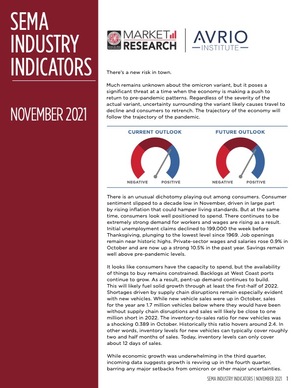By Kyle Cheng
While U.S. economic growth was underwhelming in the third quarter, incoming economic data suggests growth is revving up in the fourth quarter, barring any major setbacks from omicron or other major uncertainties.

According to the latest ”SEMA Industry Indicators” report, rising inflation is dampening consumer confidence, with sentiment dropping to a decade low in November.
Consumers look positioned to continue to spend money. Savings rates remain well above pre-pandemic levels. Additionally, there continues to be extremely strong demand for workers and wages are rising as a result. However, rising inflation is dampening consumer confidence, with sentiment dropping to a decade low in November. Despite this, expect consumer spending to continue.
The availability of things to buy, however, remains constrained. Inventory levels for new vehicles continue to be constrained. Dealer levels typically cover roughly two and a half months of sales. Today, on average, they can only cover about two weeks. Backlogs at West Coast ports also continues to grow. As a result, pent-up demand continues to build. This will likely fuel solid growth through at least the first half of 2022.
To learn more about the latest trends affecting the economy and the specialty-equipment industry, download the latest “SEMA Industry Indicators” report today at www.sema.org/research.
Other reports on trends facing the specialty-equipment industry from SEMA Market Research:
SEMA State of the Industry—Fall 2021: This report explores the current state of the specialty-equipment industry—how businesses have fared during the pandemic, how supply-chain disruptions are affecting the industry, current trends and sales performance and outlook for 2022 and beyond.
SEMA Emerging Trends: Electrification, Alternative Power and Advanced Technology: This report examines the current landscape of electrification in the United States, providing a realistic outlook for electric vehicles in the future as well as implications of advancing technology for our industry.





